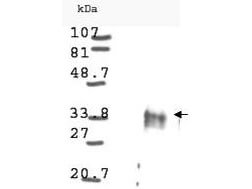Anti-Cyclin D1 (RABBIT) Antibody
Cyclin D1 Antibody
- SPECIFICATION
- CITATIONS
- PROTOCOLS
- BACKGROUND

| Host | Rabbit |
|---|---|
| Conjugate | Unconjugated |
| Target Species | Human |
| Reactivity | Human |
| Clonality | Polyclonal |
Application
| WB, E, IP, I, LCI |
| Application Note | This antibody has been tested for use in ELISA and by western blot. Specific conditions for reactivity should be optimized by the end user. Expect a band approximately 34 kDa in size corresponding to Cyclin D1 by western blotting in the appropriate cell lysate or extract. MCF7 may be used as a positive control. Anti-Cyclin D1 is suitable for the detection by immunoblot of human, rat and mouse Cyclin D1. |
| Physical State | Liquid (sterile filtered) |
| Immunogen | Anti-Cyclin D1 was produced by repeated immunizations of full length fusion protein corresponding to the human gene sequence. |
| Preservative | 0.01% (w/v) Sodium Azide |
| Gene ID | 595 |
|---|---|
| Other Names | 595 |
| Purity | This product was prepared from monospecific antiserum by delipidation and defibrination. Antiserum will specifically react with a 40-45 kDa Cyclin D1 protein from human, rat and mouse tissue. No reaction was observed against other related cyclins. Cross reactivity with Cyclin D1 from other species may also occur. |
| Storage Condition | Store vial at -20° C prior to opening. Aliquot contents and freeze at -20° C or below for extended storage. Avoid cycles of freezing and thawing. Centrifuge product if not completely clear after standing at room temperature. This product is stable for several weeks at 4° C as an undiluted liquid. Dilute only prior to immediate use. |
| Precautions Note | This product is for research use only and is not intended for therapeutic or diagnostic applications. |
| Name | CCND1 {ECO:0000303|PubMed:8204893, ECO:0000312|HGNC:HGNC:1582} |
|---|---|
| Function | Regulatory component of the cyclin D1-CDK4 (DC) complex that phosphorylates and inhibits members of the retinoblastoma (RB) protein family including RB1 and regulates the cell-cycle during G(1)/S transition (PubMed:1827756, PubMed:1833066, PubMed:19412162, PubMed:33854235, PubMed:8114739, PubMed:8302605). Phosphorylation of RB1 allows dissociation of the transcription factor E2F from the RB/E2F complex and the subsequent transcription of E2F target genes which are responsible for the progression through the G(1) phase (PubMed:1827756, PubMed:1833066, PubMed:19412162, PubMed:8114739, PubMed:8302605). Hypophosphorylates RB1 in early G(1) phase (PubMed:1827756, PubMed:1833066, PubMed:19412162, PubMed:8114739, PubMed:8302605). Cyclin D-CDK4 complexes are major integrators of various mitogenenic and antimitogenic signals (PubMed:1827756, PubMed:1833066, PubMed:19412162, PubMed:8302605). Also a substrate for SMAD3, phosphorylating SMAD3 in a cell-cycle-dependent manner and repressing its transcriptional activity (PubMed:15241418). Component of the ternary complex, cyclin D1/CDK4/CDKN1B, required for nuclear translocation and activity of the cyclin D-CDK4 complex (PubMed:9106657). Exhibits transcriptional corepressor activity with INSM1 on the NEUROD1 and INS promoters in a cell cycle-independent manner (PubMed:16569215, PubMed:18417529). |
| Cellular Location | Nucleus. Cytoplasm Nucleus membrane. Note=Cyclin D-CDK4 complexes accumulate at the nuclear membrane and are then translocated to the nucleus through interaction with KIP/CIP family members |

Thousands of laboratories across the world have published research that depended on the performance of antibodies from Abcepta to advance their research. Check out links to articles that cite our products in major peer-reviewed journals, organized by research category.
info@abcepta.com, and receive a free "I Love Antibodies" mug.
Provided below are standard protocols that you may find useful for product applications.
Background
Cyclin D1 (also known as G1/S-specific cyclin D1, PRAD1 oncogene, BCL-1 oncogene, and PRAD1: parathyroid adenomatosis 1) is encoded by a gene that belongs to the highly conserved cyclin family. Cyclins are characterized by a dramatic periodicity in protein abundance throughout the cell cycle and function as regulators of CDK kinases. Different cyclins exhibit distinct expression and degradation patterns, which contribute to the temporal coordination of each mitotic event. Cyclin D1 forms a complex with and functions as a regulatory subunit of CDK4 or CDK6, whose activity is required for cell cycle G1/S transition. This protein has been shown to interact with tumor suppressor protein Rb and the expression of this gene is regulated positively by Rb. Mutations, amplification and overexpression of this gene, which alters cell cycle progression, are observed frequently in a variety of tumors and may contribute to tumorigenesis.
If you have used an Abcepta product and would like to share how it has performed, please click on the "Submit Review" button and provide the requested information. Our staff will examine and post your review and contact you if needed.
If you have any additional inquiries please email technical services at tech@abcepta.com.













 Foundational characteristics of cancer include proliferation, angiogenesis, migration, evasion of apoptosis, and cellular immortality. Find key markers for these cellular processes and antibodies to detect them.
Foundational characteristics of cancer include proliferation, angiogenesis, migration, evasion of apoptosis, and cellular immortality. Find key markers for these cellular processes and antibodies to detect them. The SUMOplot™ Analysis Program predicts and scores sumoylation sites in your protein. SUMOylation is a post-translational modification involved in various cellular processes, such as nuclear-cytosolic transport, transcriptional regulation, apoptosis, protein stability, response to stress, and progression through the cell cycle.
The SUMOplot™ Analysis Program predicts and scores sumoylation sites in your protein. SUMOylation is a post-translational modification involved in various cellular processes, such as nuclear-cytosolic transport, transcriptional regulation, apoptosis, protein stability, response to stress, and progression through the cell cycle. The Autophagy Receptor Motif Plotter predicts and scores autophagy receptor binding sites in your protein. Identifying proteins connected to this pathway is critical to understanding the role of autophagy in physiological as well as pathological processes such as development, differentiation, neurodegenerative diseases, stress, infection, and cancer.
The Autophagy Receptor Motif Plotter predicts and scores autophagy receptor binding sites in your protein. Identifying proteins connected to this pathway is critical to understanding the role of autophagy in physiological as well as pathological processes such as development, differentiation, neurodegenerative diseases, stress, infection, and cancer.


